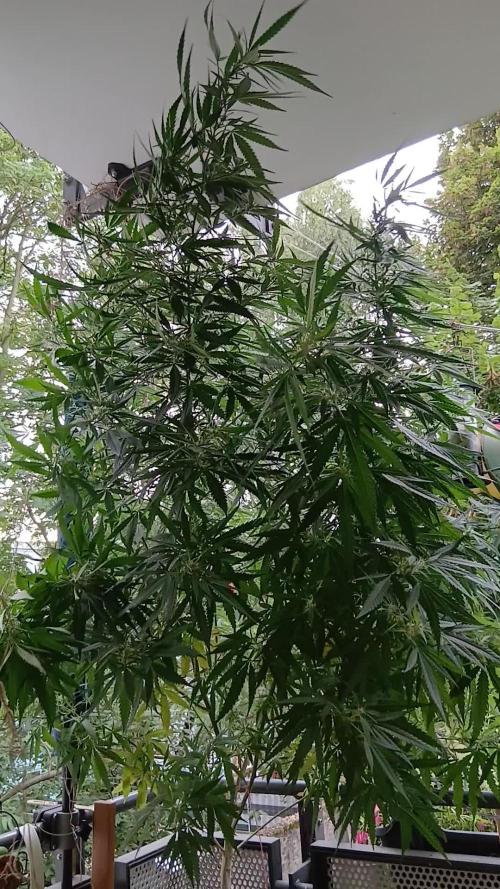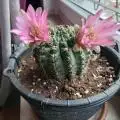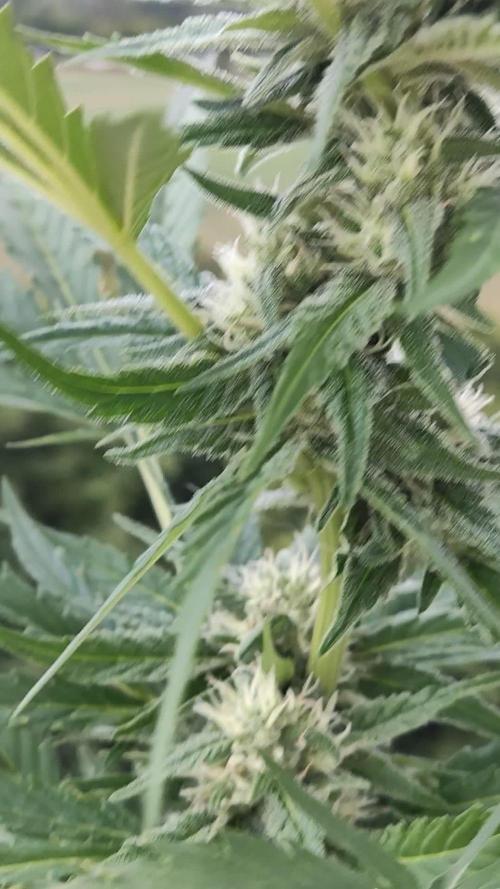The Grow Awards 2026 🏆 































Likes
Comments
Share


@BettyFlores
Follow
28.08.2025 Leider habe ich den notdürftig befestigten Ast verloren und er war tatsächlich so groß wie eine reguläre Indoor-Pflanze 😅. Es tat mir in der Seele weh, mich von ihm verabschieden zu müssen. Zurzeit ist es sehr stürmisch und regnerisch und ich kann froh sein, wenn ich auch nur eine einzige Blüte ernten werden kann.
Sie ist sooo riesig und sprengt den Balkonplatz. Unglaublich!
Likes
28
Share


@TheHighentist
Follow
Welcome to week 5 of flower.
Trichome production and the density of the buds is really starting to accelerate.
My dehumidifier is not stable, so VPD ranges from 1.2-1.4.
I lightly defoliated 31/10 and last watering was 6/11
👽👉7/11 The day after watering and the day my timer messed up my 12/12 schedule. But hope it brings no problems.
I defoliated lightly and only removed most under the SCROG line.
Even a couple of underdevoloped branches that stretched below SCROG-net got cut.
👽👉8/11 Their smell is starting to get more extreme.
👽👉9/11 I removed a bit of the bottom foliage and cleaned up the dead leaves.
It has been really tight around the SCROG net, so it was highly needed for airflow and humidity
👽👉10/11 Waterday*
ml/L change from last watering - to this.
BioHeaven 4 > 4
BioGrow 4 > 2
BioBloom 3.5 > 4
TopMax 1.5 > 4
Calmag 0.5 > 0
Rootjuice 1 > 0.5
👽👉11/11
Amazing growth in thickness and they look alot more frosty today!
👽👉12/11 Same story as yesterday
👽👉13/11 Today should have been waterday, however i was missing some nutrients so postponed till tomorrow
👇_____________________________________________
Flowering feeding recommendations:
Early bloom: 5:7:10
Mid-bloom: 6:10:15
Mid–late bloom: 4:7:10
BioHeaven The NPK ratio is 0.91-0.18-0.24;
BioGrow The NPK ratio is 4-3-6.
BioBloom The NPK ratio is 2-7-4;
Topmax The NPK ratio is 0.1-0.001-0.1;
Rootjuice The NPK ratio is 0.1-0.1-0.1;
👆_____________________________________________
Likes
26
Share


@siL01337
Follow
Now we have Monday.... And I think I will cut the baby's on Friday....this day marks the end of week 9 of flower....
Likes
17
Share


@Gasoliere_sama
Follow
The smell is very good. A good weight if I consider that I have made some mistakes with Calmag.
Likes
8
Share


@Kaotic_Herb
Follow
What's happening. There is a light midst in the atmosphere this morning. I set WISDOM up to the drip system and it worked out perfectly.
WISDOM was planted this past winter. She actually grew up in a window seal most of here life.
It was a slow progression but she still came out on top.
Likes
4
Share


@IamCy
Follow
Here we go into flower. If what they say is true, we're in for a nice color show.
Likes
7
Share


@Stickygreens420
Follow
Overall I was happy with this strain and I did not have many problems growing. Plant was healthy for the entire grow with little to no signs of deficiencies. The only issue I had with the plant was it started sprouting a good amount of nanners the last few weeks of flower. I was able to pull them all off with tweezers, so now I just need to hope they didn't pollinate any of the other plants. Still need to dry for another two weeks, so I will provide a smoke report at that point. The plant is loud and still has that sweet funk. Excited to smoke it. I will be drying at 60° and 60% RH for 12 to 16 days.
12/28/2022: day 10 of drying at 60° and 60% RH. Smallest branches are starting to snap, but most of the main branches are not providing a noticable cracking sound yet. Buds are a little on the airy side, from what I can tell, but I'll provide a final update once trimmed.
1/2/2023: started trimming today, which is day 15 at 60° and 60% RH
1/4/2022: finished trimming and totaled 84 grams, so just under 3 oz. I know I said earlier the bud was a little airy, but I must have grabbed some lowers. Not the densest ever, but pretty nice nugs. Found some additional nanners I missed, but no seeds so far. Pretty happy with the results.
Processing
Likes
5
Share


@Kourtney80
Follow
I’ve started useing rain water to water them. They still look healthy as they are keeping they’re rich green colour I jus hope they’ll survive😅
I also have a new 600w light for them
Likes
16
Share


@eldruida_lamota
Follow
Esa familia , estamos otra vez y aquí actualizo la quinta semana de floración de las BlueBerry Cheese del banco de semillas ZambezaSeeds.
Estas tienen buen color y el proceso de floración es el correcto su progreso es increíble.
Ahora empezaré a aplicar el ExplotaCogollos de Agrobeta que es Brutal como compacta las flores , palabra.
Que ganas ya de acabar estos proyectos y empezar con cosas serias.
Os adelanto que lo próximo que que viene son Gelato y Lava Cake, y después Titán F1.
Agrobeta:
https://www.agrobeta.com/agrobetatiendaonline/36-abonos-canamo
Mars hydro:
Code discount: EL420
https://www.mars-hydro.com/
Las maximas de temperatura no superan los 26 grados y las mínimas no bajan 20, así que no me puedo quejar.
Los niveles de humedad también son los correctos van entre 50%/65% de humedad relativa.
Por supuesto el Ph lo estamos dejando alrededor de 6.
Hasta aquí es todo, buenos humos 💨💨💨.
Likes
5
Share


@SkunkyDog420
Follow
Hallo zusammen 🤙.
Sie wächst sehr schön und macht keine Probleme.
Rabattcode für den BIOTABS-Webshop https://biotabs.nl/en/shop/ GDBT420, damit erhalten Sie 15 Prozent
Likes
49
Share


@Hashy
Follow
Light settings
12/12 on at 9.00am off 9.00pm
Light power= 62% 150w
Radiator settings
LIghts on
Turn on if temp drops below 23c
Turn off if temp goes above 23c
Lights off
Turn on if temp drops below 19c
Turn off if temp goes above 19c
Dehumidifier settings
LIghts on
Turn off if humidity drops below 60%
Turn on if humidity goes above 60%
LIghts off
Turn off if humidity drops below 62%
Turn on if humidity goes above 62%
Extractor settings
temperature 24c with 1c steps
Humidity 54% with 2% steps
Max speed 9
Min speed 4
VPD aim 0.8-1.2
Wednesday 1/3/23 Day 36
Autofeed 5 15 minute runs
Water 10L Ec=0.21 Ph=6.5/7.0
3L left
Roughly 2.3L each.
#2 run 0.1L Ec=3.86 Ph=5.7
7.15pm Lowered light 3cm
#2 DLI= 25.5
Thursday 2/3/23 Day 37
10.00pm
Extractor settings
temperature 24c with 1c steps
Humidity 54% with 2% steps
Max speed 10
Min speed 5
Friday 3/3/23 Day 38
Autofeed 5 15 minute runs
Feed 10L Ec=1.73 Ph=6.3
2.5L left.
Roughly 2.5L each.
#2 run 0.6L Ec=2.14 Ph=6.1
Saturday 4/3/23 Day 39
5.00pm
#2 Height= 30CM Dist= 38CM DLI= 26.6
Lifted lights 3 clicks and Lst and defoliate
Sunday 5/3/23 Day 40
Bit of Lst and scrogging
Monday 6/3/23 Day 41
Autofeed 5 15 minute runs
Feed 12L Ec=1.78 Ph=6.3/6.3
4.5L left
Roughly 2.5L each.
#2 run 0.25L Ec=2.4 Ph=6.1
#2 DLI=26.9
Lifted light
#2 Height= 31CM Dist= 45CM DLI= 20.7
Tuesday 7/3/23 Day 42 (Day 14 flower)
Radiator didn't come on when it should have. It was cold today and I don't understand why the sensor didn't trigger the Radiator.
#2 Height= 31CM Dist= 45CM DLI= 20.7
The 2nd week of flower has gone well. I have tried to keep the canopy of the overall grow as level as I can, the only problem with running different strains is they all have different traits and grow at different speeds. Nearer the end of the week the weather started getting cold again so the radiator is going to be working a bit more over the next week or 2.
#2 Tropicana Cookies FF stil hasn't started stretching, she is mega bushy and has quite a cool funky look to her, I haven't managed to spread her out as much as I wanted to so I'll hope she will be OK.
Power used for week
Light
(1.77+1.84+1.84+1.84+1.84+1.83+1.84)=12.8Kw
Extractor
(0.19+0.24+0.25+0.27+0.31+0.31+0.41)=1.98Kw
Fans
(0.48+0.47+0.47+0.47+0.47+0.48+0.48)=3.32Kw
Dehumidifier
(0.69+0.65+0.0+0.01+0.6+0.02+0.69)=2.66Kw
Radiator
(3.3+3.98+3.38+3.16+3.8+3.31+4.07)=25.0Kw
Water pump.
(0.02+0.0+0.02+0.0+0.0+0.2+0.0)=0.24Kw
Total for the week=46Kw
Back in a week.
Thanks for stopping by.
Likes
7
Share


@gablmo
Follow
Another busy week with the vege. I gave it microbes, a HID lamp at 400 watts, sprayed for bugs and also covered the media with plastic wrap to get rid of 3 or 4 gnarts and of course a had another flood with the GoGro water system and I took one plant out of the garden because she is frozen in time. I still don't know why. The trellis is doing good. Lots of work.
Likes
8
Share


@PortkeyCannabis
Follow
Got these two that I’m am very excited about I have never grown either of these or any fastbuds so yeah let’s go!! Stay tuned!!
Likes
61
Share


@Dunk_Junk
Follow
Well she was a bountiful harvest!!!
It wasn't the purple phenotype though.
Fantastic plant though!!!!!!!!!!!!!!!!!!! 💪
Likes
9
Share


@bioaccessory
Follow
It was an invaluable experience growing outdoors. In general, we can safely conclude that it is not recommended to plant photoperiod plants at my latitude, you need to look towards early stains.
Upd: From part of the harvest, I prepared cannabutter, the cooking process in the photo)
Upd2:Warning:! A very strong concentrate is taught, not for beginners!
Likes
7
Share


@Mr_nugs_lover_David
Follow
Looking absolutely gorgeous on the 2nd week after planted this 5 Lemon cream kush auto by Spliff seeds are growing up super fast and I must say that the 5 plants look very similar to each other, let's see how this ladies surprise me on this sog run with 29 plants and 9 different strains





















